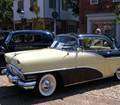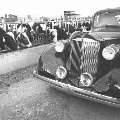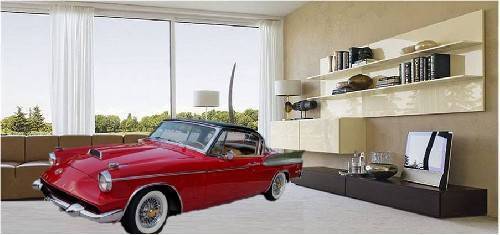|
Re: climate controlled storage
|
||||
|---|---|---|---|---|
|
Just popping in
|
West Texas is a great place to store cars regarding the low humidity, you will have no worries about rust or mildew. The issues there are high temperature baking plastics and interior materials, and potential varmint damage. I live in McKinney near Dallas which is more temperate and just have my 3-car garage. I have an exterminator in quarterly to bait for mice and spray for bugs. I installed a large window air conditioner which allows me to work comfortably in the summer, but I doubt it would be practical to cool a storage garage all the time...
Posted on: 2013/4/7 10:44
|
|||
|
Don Rundgren
McKinney, Texas 1934 1100 Eight Sedan |
||||
|
||||
|
Re: climate controlled storage
|
||||
|---|---|---|---|---|
|
Quite a regular
|
65 - 70 degrees
25 - 30 % humidity And just as important is to not have wide lows and highs.
Posted on: 2013/4/7 11:32
|
|||
|
||||
|
Re: climate controlled storage
|
||||
|---|---|---|---|---|
|
Home away from home
|
http://www.philamuseum.org/conservation/10.html?page=3
What effects do exposure to temperature and humidity have on a museum's collections? Damage from physical stress. High relative humidity can cause the growth of mold and fungi. The most significant aspect of temperature is its effect on relative humidity (RH). Relative Humidity is a measure of the amount of moisture in the air relative to the amount the air is capable of holding, expressed as a percentage. If the air at a particular temperature contains half the water vapor it can hold at that temperature, the relative humidity is 50%. Acute changes in temperature and humidity will cause swelling and contraction as the materials in an object or artifact attempt to adjust to the environment. Objects are often composed of more than one type of material. Each material responds differently to water vapor in the air and adjusts to its particular EMC (equilibrium moisture content) at different relative humidities. Of particular concern are the internal stresses created by expansion and contraction of the different materials as moisture diffuses into or out of the surrounding air. Three different forms of deterioration caused by humidity: Mode Effect Dimensional Change warping, dislocation of joints, splitting, breaking of fibers, delamination, loss of surface material, cracking Chemical Reaction corrosion of metals, fading of dyes, weeping or crizzling glass (clouding), cystallization and movement of salts, disintegration and yellowing of paper Biodeterioration mold growth (RH 70% or above), bacteria At the Museum, objects are stored and displayed in stable relative humidity and temperature to minimize the risk of damage. When prepared for transport, objects are packed carefully using insulating foams and barrier films (to control variations in temperature and humidity) in custom constructed crates. How can relative humidity be measured? The recording hygrothermograph is one of the most common devices in use by museums today to measure temperature and RH. You may see these in discreet locations throughout the Museum galleries. The charts on the drum hold a one-week record of readings made by a sensor of human or synthetic hair (for humidity) and a bi-metallic strip (for temperature). Each sensor is attached to a separate pen which in turn moves up or down in response to a change in humidity or temperature. Because of the sensitive nature of the mechanism, the hygrothermograph requires frequent calibration. One device used in calibration because of its reliability is called the psychrometer. A psychrometer consists of two ordinary thermometers. The dry bulb simply reads air temperature. The wet bulb has a fabric sleeve fitted over the mercury bulb, which is wetted with distilled water. Swinging this instrument around will move air past the wet bulb cooling it by evaporation of water and thus giving a lower temperature reading than the dry bulb (provided the air is not fully saturated with moisture.) The difference between the temperature of the wet bulb and dry bulb is calculated and RH is determined from a chart called a hygrometric table. A few other devices used to measure temperature and RH levels in the museum environment are: Dial Hygrometer - this device can be hung on a wall or shelf mounted. Measures temperature and humidity within 3 degrees. Data Logger - this device can record, display and download temperature and humidity information to a computer for analysis and tracking. Analog Thermohygrometer - this device is placed discreetly in exhibit cases to monitor temperature and humidity levels Temp/Humidity Cards - these cards record temp/humidity levels by inidcating a change in color from blue (drier) to pink (wetter). What RH levels are ideal in the museum environment? General guidelines for temperature and humidity conditions within the Museum are illustrated in the chart below: Type of Object %RH Degrees in Farenheit Furniture 45 - 55% 68 - 72? Paintings and Paper Textiles Objects Some objects require controlled microenvironments. For example some metal objects are displayed at low relative humidity to slow the rate of corrosion. Other materials, such as high-fired ceramics, are less sensitive to relative humidity. What is being done in the Museum to control temperature and humidity levels? Sophisticated air handling units are the best protection against sharp fluctuations in temperature and humidity. The Museum utilizes a complex network of air handling systems that regulate temperature and humidity levels throughout the entire building. A computer controlled HVAC system maintains 70? temperature/50% humidity environmental condition year round in the galleries and storage areas. Each area within the Museum contains a sensor which will trip an alert if the levels go out of the normal range (?2?). In the case of an alert, building maintenance crews can react quickly to resolve any problems. This provides invaluable environmental protection for the Museum's collections. Humidity buffering materials such as silica gel can be used to control relative humidity within a closed microenvironment like a display or storage case.
Posted on: 2013/4/7 15:41
|
|||
|
||||
|
Re: climate controlled storage
|
||||
|---|---|---|---|---|
|
Home away from home

|
Gee, I wish I were a billionaire so I could afford to store my Clipper like this ...

Posted on: 2013/4/7 17:08
|
|||
|
You can make a lot of really neat things from the parts left over after you rebuild your engine ...
|
||||
|
||||
|
Re: climate controlled storage
|
||||
|---|---|---|---|---|
|
Forum Ambassador

|
32model901, you bring back memories of using a sling psychrometer 40 or more years ago.
Posted on: 2013/4/7 17:21
|
|||
|
||||
|
Re: climate controlled storage
|
||||
|---|---|---|---|---|
|
Home away from home

|
I sure appreciate the sheer amount of information about humidity, relative humidity, temp etc. but how do I translate all that into something practical here?
Summers are usually in the90's with about 2-3 wks in the upper 90's or tripple digits. Humidity aprox 10-15% Winters are mild with occasionally freezing temp down to the lower teens. Humidity aprox 10-15%. Should I run a humidifyer in my storage? The storage has 2 little windows (12 by 6 inches) so sunlight is minimum, I plan on covering those with newspaper to make sure theres no straight sunlight on the vehicles. I think I should put an ac in there for the summertime as well.
Posted on: 2013/4/7 20:32
|
|||
|
I can explain it to you but I can't understand it for you
 Bad company corrupts good character! Farming: the art of losing money while working 100 hours a week to feed people who think you are trying to kill them |
||||
|
||||
|
Re: climate controlled storage
|
||||
|---|---|---|---|---|
|
Home away from home

|
I think you folks are really on the right track ... in fact it occurred to me that you could really enjoy your Packard a lot more -- and keep it in a much lower-cost climate-controlled environment -- if you do as a friend of mine does and keep your car in your living room. That way you not only avoid bird poop and other inconveniences, while at the same time you can sit in your car and watch your big-screen TV! It's a lot like being at a drive-in theater!
Posted on: 2013/4/9 13:36
|
|||
|
You can make a lot of really neat things from the parts left over after you rebuild your engine ...
|
||||
|
||||
|
Re: climate controlled storage
|
||||
|---|---|---|---|---|
|
Forum Ambassador
|
Humidity is your enemy, if the car is old enough to have a wood framed body too little humidity is a problem.
Posted on: 2013/4/9 13:57
|
|||
|
||||
|
Re: climate controlled storage
|
||||
|---|---|---|---|---|
|
Home away from home

|
Now where is the middle of the road when it comes to humidity?
Posted on: 2013/4/9 14:06
|
|||
|
I can explain it to you but I can't understand it for you
 Bad company corrupts good character! Farming: the art of losing money while working 100 hours a week to feed people who think you are trying to kill them |
||||
|
||||

 (43.50 KB)
(43.50 KB)






